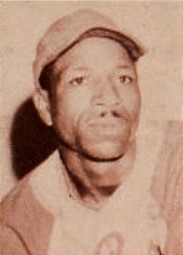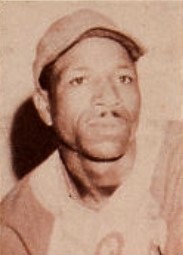Charlie Rivera
 Charlie Rivera was a third baseman, second baseman, and shortstop who played with several clubs in the Negro leagues for parts of five seasons, from 1939 to 1944. He was a right-handed hitter who stood 5-feet-9 and weighed 155 pounds.1
Charlie Rivera was a third baseman, second baseman, and shortstop who played with several clubs in the Negro leagues for parts of five seasons, from 1939 to 1944. He was a right-handed hitter who stood 5-feet-9 and weighed 155 pounds.1
Carlos Manuel Lavezzari y Sierra was born to Manuel Lavezzari and Trinidad Sierra on September 6, 1912, in Santurce, Puerto Rico.2 Little is known about his early years on the island. On September 28, 1918, he and his siblings boarded the S.S. Philadelphia with his mother and relocated to New York City.3 Whatever happened to his father is a mystery.
At this point, his name was shortened to “Carlos M. Sierra.”4 However, by 1930, with his father not found in the US Census, his name was rendered as Carlos Lavezzary Revera; his surname was finally modified to “Rivera”;5 and his first name was later anglicized to “Charles.”6 Because his education was limited to grammar school, Rivera had few employment opportunities.7 When he found work, it was as a helper in a laundry,8 but he eventually became a carpenter’s apprentice.9
Baseball historian James Riley concluded that Rivera broke into the Negro Leagues in 1933 as a member of the Cuban Stars.10 However, contemporary newspaper accounts11 and Seamheads.com12 have determined that this player was not Carlos Rivera, but Nenene Rivera, a Puerto Rican who played shortstop for an independent team, Pollock’s Cuban Stars.
Research has not uncovered how Charlie Rivera got interested in baseball. However, at some point, he returned to Puerto Rico and got his start in the game playing for $10 a day.13 He played semiprofessionally for the Guayama baseball club in the Puerto Rican winter league in 1938-39.14 While playing for Guayama, Rivera caught legendary pitcher Satchel Paige.15
Baseball historian Adrian Burgos interviewed Rivera in the mid-1990s, and Rivera related that he volunteered to catch Paige in 1938 when regular catcher Bill Perkins was injured and his backup declined to play.16 Burgos was skeptical about the claim since Rivera was an infielder, not a catcher.17 However, during a trip to Puerto Rico, he later verified the story by reviewing Guyama’s official scorebook from that season. He identified Rivera as a catcher in Guayama’s first game and concluded that the story was true. He described Rivera’s memory of the game:
Since he had grown up mostly in New York, Rivera communicated with Satchel Paige in English. Satchel jokingly called Rivera ‘jamaiquino’ (Jamaican) because he spoke English without a Spanish accent. Paige’s pinpoint control was legendary. Satchel just told Rivera to stick the catcher’s mitt where he wanted the ball and not to worry about calling signals. He’ll just throw whatever pitch he wanted, but to trust him, he will hit the mitt. So Rivera did exactly what Paige told him. Paige delivered as promised, hitting the catcher’s mitt every time.18
By 1939, Rivera joined the Baltimore Elite Giants as a 26-year-old rookie, although the exact circumstances of his signing have been lost to history. The team included two future Hall of Famers at catcher, 41-year-old Biz Mackey and 17-year-old Roy Campanella. According to Seamheads, Rivera batted .256 in 11 games as a third baseman for the Elite Giants, primarily as player-manager Felton Snow’s backup.19
Rivera’s name first appeared in a box score on May 31, in a doubleheader split against the New York Black Yankees.20 Rivera played well, contributing two hits and scoring a run in the opener and getting another hit in the second game before 7,000 fans.21
Rivera’s season highlights included twice collecting two hits in wins over the Philadelphia Stars22 and driving in the go-ahead run against the Manheim Barons.23 He added two more hits against the Poughkeepsie All-Stars.24 Perhaps Rivera’s best moment of the season came in a loss to the Norristown Pros. He hit a “freak homer” in the second, “which cut over third base and then went behind the foul line.”25
Baltimore finished in fourth place in the Negro National League II. Despite posting an uneven record of 21-23, the Elite Giants qualified for the NNL playoffs. They defeated the Newark Eagles in the first round, three games to one.26 Baltimore then defeated the Homestead Grays, three games to one (with one tie) to capture the NNL title.27 Whatever contributions Rivera made to the Elite Giants’ championship run were not featured in the news reports of the postseason games, and are not documented by Seamheads. Baltimore released Rivera after the season.28
Rivera signed to play second base for the Brooklyn Royal Giants, which had previously been a top-tier Negro League team from 1905 to the mid-1930s. By 1940, the Royal Giants were a semipro outfit that barnstormed across the Northeast, the South, and the Midwest.29 Midway through the campaign, Brooklyn reportedly had an improbable record of 40-5.30 Most of the stories about the Royal Giants were previews of coming games, rather than game accounts. Whenever box scores did appear, Rivera’s performance was often notable:
In a sweep of a doubleheader over the Bacharach Giants, he had two hits, two walks, and scored a run.31 He followed up that performance with a hit and a run scored in a win over the Ethiopian Clowns.32 In August, Rivera collected four hits in a doubleheader against the Mount Vernon Scarlets and turned three double plays.33 And he had two hits, including a triple, and scored a run, in a late-season win over Jesse Owens’ Toledo Crawfords.34
In 1941 Rivera joined another semipro barnstorming team, the Miami Ethiopian Clowns. The Clowns were known as much for entertaining fans with their comedy routines and unusual nicknames as they were for playing baseball, as historian Brian Carroll observed:
Obscured by these vivid names and the vaudevillian antics that went with them is the fact that these entertainers also played first-rate baseball – as evidenced by the team’s many Negro American League and semi-pro tournament titles – and did so for longer than any other Negro League team.35
Rivera played well in spring training for the Ethiopian Clowns. One report noted, “Charlie Rivera, Puerta [sic] Rican winter league star, is playing a bang-up of a game for the Clowns at shortstop and hitting the ball hard.”36
Newspapers inevitably focused on the Clowns’ performance at shadow ball, pepper, phantom fielding, and vaudevillian acts, rather than their baseball skills. One preview featured a photograph depicting Rivera and three other players wearing clown makeup.37 However, he was better known for his on-field play. One story noted, “[t]he Clowns are more than a team of comedians; however, they are the champions of national Negro baseball and boast the services of Charlie Rivera of the Guayama, Puerto Rico, team, which won the international semi-pro title at San Juan last season.”38
As with the Royal Giants the year before, newspapers probably exaggerated the ability of the Clowns. One article reported that the Clowns had a record of 58-6.39 Another claimed that the team had not lost a series in five years.40
Rivera was one of the keys to the club’s success. In June, his single drove in the winning run in a 1-0 victory in the first game of a doubleheader against the Kansas City Monarchs. Although the Clowns lost the second game, Rivera added two more hits and scored a run.41 While box scores for the Clowns’ games were not common, the ones that exist show Rivera had five other multihit games.42 He also homered in a doubleheader sweep of the Victoria All-Stars in July.43
In another win over the Monarchs, his defense also shined. The game summary noted that “[s]hortstop Rivera of the Clowns pulled off two electrifying fielding plays, throwing out a runner from deepest short once and racing in behind the mound, head down, to snap up a ground ball and beat a fast runner another time.”44
After two years of barnstorming with independent squads, how Rivera spent the 1942 season is a mystery. His name did not appear in any stories about the Ethiopian Clowns or the Brooklyn Royal Giants. He also did not appear in games for any NNL or Negro American League franchises. Whether he played in 1942 has yet to be verified. In 1943, Rivera signed to return to the Clowns,45 who had joined the NAL and rebranded as the Cincinnati Clowns.46 However, his time with the Clowns was brief; he was traded to the New York Cubans for Buster Haywood during spring training.47 With the Cubans, Rivera, who was now 30, filled a utility infielder role.48
Leading off for the team in a game against the Homestead Grays in June, Rivera had two hits and scored two runs in a wild 10-9 win played in front of 10,000 fans at Griffith Stadium in Washington.49 Later that summer, the Cubans faced the Philadelphia Stars and the Kansas City Monarchs in a doubleheader before 20,000 patrons at Yankee Stadium.50 Rivera had a hit in the first game and reached on an error against the Monarchs to help New York chase Satchel Paige from the second game.51
The Cubans had a record of 19-14-1 in 1943 but finished in a distant second place to the Homestead Grays, who ran away with the NNL pennant and later won the Negro League World Series. For his part, Rivera hit .250 with 12 RBIs and one home run for the Cubans.
The next year, 1944, was Rivera’s final season in professional baseball. According to The Biographical Encyclopedia of the Negro Baseball Leagues, Rivera “split his playing time between the New York Cubans and New York Black Yankees.”52 However, no news stories or box scores have been located showing that Rivera played for the Cubans. According to Seamheads, he appeared only for the Black Yankees although the details of his signing have been lost to history. The Black Yankees had a terrible season, finishing in last place in the NNL with a forgettable 7-32 record.
Rivera played third base and batted .244. In probably his final appearance in a box score, he collected three hits while driving in three runs and scoring one in a doubleheader against the Brooklyn Bushwicks.53
On October 28, 1944, Rivera enlisted in the US Army and served for three years as a private.54 In 1946 he married Amma Martinez in the Bronx, where the couple eventually settled.55 Rivera then spent many years an elevator operator at Macy’s department store in New York City,”56 while his wife was a homemaker.57
In 1993 Rivera was honored with other former Negro League players at the Upper Deck Heroes of Baseball All-Star Game at Camden Yards in Baltimore.58 He expressed his gratitude to the fans at the game in an interview with Bill Rabinowitz. He marveled at his baseball career, saying, “When I saw I could play for money, I was happy as a lark. I could play a game I loved, and they were going to pay me. Oh man.” Although he missed out on playing in the major leagues, he added, “My wife told me that we were born too soon. … I can’t be mad at that because that’s… the way it had to happen.”
Rivera died on July 27, 2003, in the Bronx at the age of 90. His burial details are unknown.59
In 2020, Major League Baseball recognized seven professional Negro Leagues that operated from 1920 to 1948 as having major-league status.60 Thus, Rivera has finally been recognized as a major leaguer for his play in the NNL.
Sources and Acknowledgments
Except where otherwise indicated, all player statistics and team records were taken from Seamheads.com.
The author is grateful to the late Rick Bush, who was always willing to cheerfully lend a hand to any researcher and take time to answer emails seeking his help. Charles Rivera does not have a player file with the National Baseball Hall of Fame Library, which added to the difficulty in researching his life. However, Rick provided crucial documents detailing Rivera’s early life, military service, and family in an April 27, 2023, email to the author, which is indispensable to this biography. Sadly, Rick died suddenly on October 8, 2023. He will be missed by the author and anyone who was fortunate enough to get to know him, even if only through emails. The author also appreciates editor Bill Nowlin’s usual patience and helpful suggestions.
Notes
1 United States World War II Draft Cards Young Men, 1940-1947; https://www.seamheads.com/NegroLgs/player.php?playerID=river01cha.
2 Acta Nacimiento, Folio 88, Numero 1223, Registro Civil, San Juan, Puerto Rico. Thanks to Gary Ashwill.
3 United States, Departing Passenger and Crew Lists, 1914-1966, accessed at Ancestry.com.
4 United States, Departing Passenger and Crew Lists, 1914-1966, accessed at Ancestry.com.
5 New York. Manhattan. 1930 U.S. Census (Revera); United States, Departing Passenger and Crew Lists, 1914-1966, accessed at Ancestry.com (Rivera); United States World War II Draft Cards Young Men, 1940-1947; New York, New York, U.S., Marriage License Indexes, 1907-2018, accessed at Ancestry.com; Bronx, New York, 1940. U.S. Census.
6 New York, U.S., Arriving Passenger and Crew Lists (including Castle Garden and Ellis Island), 1820-1957, accessed at Ancestry.com.
7 United States, World War II Army Enlistment Records, 1938-1946, accessed at Ancestry.com.
8 New York. Manhattan. 1930 U.S. Census.
9 United States, World War II Army Enlistment Records, 1938-1946, accessed at Ancestry.com.
10 James A. Riley, The Biographical Encyclopedia of the Negro Baseball Leagues (New York: Carroll & Graf Publishers, 1994), 667.
11 “Cuban Stars Play Local Hornets Today,” Wilmington (Delaware) Morning News, May 15, 1933: 11; “Cuban Stars Invade City Stadium For Clashes With Pats Sunday, Offering Real Test For Locals,” Paterson (New Jersey) News, May 18, 1933: 26; “ALCOS Meet Famous Syd Pollock’s Cubans Here In Night Game,” Dunkirk (New York) Evening Observer, June 1, 1933: 14; “Cubans’ Outlook Bright,” Pittsburgh Courier, June 10, 1933: 15; “Nebraskans Win at Ute,” Sioux City (Iowa) Journal, July 26, 1933: 9; “Cubans to Meet Bats Wednesday,” Mason City (Iowa) Globe-Gazette, August 9, 1933: 9.
12 https://www.seamheads.com/NegroLgs/player.php?playerID=river01nen.
13 Bill Rabinowitz, “Charlie Rivera: A First-Class Act,” York (Pennsylvania) Daily Record, July 13, 1993: 25; United States World War II Draft Cards Young Men, 1940-1947, accessed at Ancestry.com.
14 “Clown Nine Plans Show,” Cincinnati Post, June 3, 1941: 13; Adrian Burgos Jr. “El Profe: ‘I Caught Satchel Paige,’” lavidabasebell.com, June 18, 2018, accessed at https://www.lavidabaseball.com/el-profe-satchel-paige-charlie-rivera/.
15 “El Profe: ‘I Caught Satchel Paige.’”
16 “El Profe: ‘I Caught Satchel Paige.’”
17 “El Profe: ‘I Caught Satchel Paige.’”
18 “El Profe: ‘I Caught Satchel Paige.’”
19 https://www.seamheads.com/NegroLgs/team.php?yearID=1939&teamID=BEG&LGOrd=1.
20 “Black Yankees in Even Break,” Brooklyn Daily Eagle, May 31, 1939: 18. He sometimes appeared in box scores and newspaper stories as “Revere,” “Riveria,” and “Riberia.”
21 “Black Yankees in Even Break.”
22 “NNL League Dope,” New York Amsterdam News, June 24, 1939: 15; “Philly Stars Win 2 Out of Three,” New York Amsterdam News, July 15, 1939: 15.
23 “Manheim Lads Drop 4-3 Tilt to Baltimore,” Lancaster (Pennsylvania) Intelligencer Journal, June 29, 1939: 16. The Barons were described as “the dark horse of the Lebanon Valley league.” See “Baltimore Elite Giants Play Manheim Tonight,”Lancaster Intelligencer Journal, June 28, 1939: 10.
24 “All-Stars Drop Hot Game To Elite Giants Team 7-1,” Poughkeepsie (New York) Eagle-News, July 13, 1939: 8.
25 No Sheriff, “Norristown Sluggers Blast Three Hurlers for 19 Hits; Smith Gives Up Seven Blows,” Norristown (Pennsylvania) Times Herald, July 17, 1939: 7.
26 Ralph Boyd, “Elites Whip Eagles to Gain Championship Series,” Baltimore Afro-American, September 16, 1939: 22.
27 John H. Whoric, “Sportorials,” Connellsville (Pennsylvania) Daily Courier, September 29, 1939: 16; “Baltimore Whips Homestead Grays for Title,” Chicago Defender, September 30, 1939: 9; “Elite Giants Win National League Championship,” Baltimore Afro-American, September 30, 1939: 21.
28 Riley, 667.
29 “Negro All-Stars Will Play Here,” Macon (Georgia) Evening News, May 20, 1940: 1; “Wilkins Will Hurl Against Colored Aces,” Munster (Indiana) Times, July 5, 1940: 17; “Brooklyn Royal Giants Face Puerto Rican All-Stars Here Wednesday,” Capital Times (Madison, Wisconsin), July 9, 1940: 13; “Royal Giants, Stars Play Here Tonight,” Wisconsin State Journal (Madison), July 10, 1940: 15; “Royal Giants to Meet Citizens Here Tonight,” Muncie Evening Press, July 18, 1940: 16; “Jenkins Star of Bacharach Nine,” Harrisburg (Pennsylvania) Evening News, July 20, 1940: 12; “Wilkins Will Hurl Against Colored Aces,” Hammond (Indiana) Times, July 5, 1940: 44; “One Six-Run Inning Beats Fraser Club,” Lynn (Massachusetts) Daily Evening Item, July 29, 1940: 9; “Outfielder Hits Single in Tenth for Winning Run,” Kingston (New York) Daily Freeman, August 10, 1940: 11; “Royal Giants Here Tonight,” Biddeford (Maine) Daily Journal, August 20, 1940: 6.
30 “Citizens Meet Giants Tonight,” Muncie Star Press, July 18, 1940: 8.
31 “Brooklyn Giants Sweep Twin Bill; Thomas Shines,” Harrisburg Evening News, July 22, 1940: 13.
32 “Royals Row Way to 6-3 Win Over Ethiopians,“ Sunbury (Pennsylvania) Daily Item, June 25, 1940: 13.
33 “Adams’ Hitting Streak Stopped At 40 Games,” White Plains (New York) Daily Argus, August 12, 1940: 8.
34 “Brooklyn Defeats Toledo Nine, 6-2,” Harrisburg Telegraph, August 26, 1940: 13.
35 Brian Carroll, “Black Baseball’s ‘Funmakers’: Taking the Miami Ethiopian Clowns Seriously,” The National Pastime: Baseball in the Sunshine State (Miami, 2016), accessed at https://sabr.org/journal/article/black-baseballs-funmakers-taking-the-miami-ethiopian-clowns-seriously/.
36 “Ethiopian Clowns in Four During Week,” Phoenix (Arizona) Index, May 3, 1941: 4.
37 “Play Here Tomorrow,” Victoria (British Columbia) Times Colonist, July 18, 1941: 11
38 “Clown Nine Plans Show.”
39 “Satchel Paige Faces Clowns at Crosley Field Today,” Cincinnati Enquirer, June 8, 1941: 33.
40 “Packer Club Drilling for Triple Bid,” Austin (Minnesota) Daily Herald, June 20, 1941: 8.
41 “Negro Nines,” Cincinnati Enquirer, June 9, 1941: 18.
42 “Locals Take Bad Beating From Clowns,” Bremerton (Washington) Daily News Searchlight, July 16, 1941: 9 (two hits); “Clowns Lose to Boston, Bentley,” The Province (Vancouver, British Columbia), July 19, 1941: 15 (two hits); “Ethiopians Top Cuban Stars by 6-0 Score,” Montana Standard (Butte), July 28, 1941: 8 (two hits); Woody Cannon, “Fans Agree Colorado Ball Clubs Could at Least Hit the Seed,” Salt Lake Telegram (Salt Lake City, Utah), August 1, 1941: 18 (three hits); “Circuit Clout Climaxes 4-Run Rally,” Mansfield (Ohio) News-Journal, September 6, 1941: 7 (two hits).
43 “Packed Stands Enjoy Clowns,” Victoria Times Colonist, July 21, 1941: 10.
44 “Negro Nines Thrill Year’s Best Crowd,” Winnipeg (Manitoba) Tribune, June 26, 1941: 19.
45 “Clowns Hope To Win N.A.L. 43 Pennant,” St. Louis Argus, April 2, 1943: 10.
46 Carroll.
47 “Clowns Sign Local Stars,” Cincinnati Post, April 14, 1943: 14; “Clowns’ Bassett Fine Comedian,” Birmingham (Alabama) Post, April 16, 1943: 22.
48 “New York Cubans Send Probable Lineup for Tilt Tomorrow Night,” Lafayette (Indiana) Journal and Courier, June 17, 1943: 18.
49 “Grays, Cubans Split Before 10,000 Fans,” Pittsburgh Courier, June 19, 1943: 18.
50 “‘Satch’ is Blasted Before 20,000 Fans at Yankee Stadium,” Pittsburgh Courier, August 14, 1943: 18.
51 “‘Satch’ is Blasted Before 20,000 Fans at Yankee Stadium.”
52 Riley, 667.
53 “The Bushwick’s Scores,” Brooklyn Citizen, August 28, 1944: 6.
54 United States World War II Army Enlistment Records, 1938-1946; Bill Rabinowitz, “Charlie Rivera: A First-Class Act.”
55 New York. Bronx County. 1950 US Census.
56 Rabinowitz.
57 New York. Bronx County. 1950 US Census.
58 Rabinowitz.
59 https://www.findagrave.com/memorial/99120409/carlos-rivera:
60 https://www.mlb.com/news/negro-leagues-given-major-league-status-for-baseball-records-stats.
Full Name
Carlos Lavezzari Rivera
Born
September 18, 1911 at Santurce, PR (USA)
Died
July 27, 2003 at New York, NY (USA)
If you can help us improve this player’s biography, contact us.


